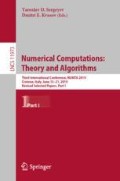Abstract
In previous work, we have presented a computational model and experimental results that quantify the dynamic mechanisms of auto-regulation in E. coli in response to varying external phosphate levels. In a cycle of deterministic ODE simulations and experimental verification, our model predicts and explores phenotypes with various modifications at the genetic level that can optimise inorganic phosphate intake. Here, we extend our analysis with extensive stochastic simulations at a single-cell level so that noise due to small numbers of certain molecules, e.g., genetic material, can be better observed. For the simulations, we resort to a conservative extension of Gillespie’s stochastic simulation algorithm that can be used to quantify the information flow in the biochemical system. Besides the common time series analysis, we present a dynamic visualisation of the time evolution of the model mechanisms in the form of a video, which is of independent interest. We argue that our stochastic analysis of information flow provides insights for designing more stable synthetic applications that are not affected by noise.
Access this chapter
Tax calculation will be finalised at checkout
Purchases are for personal use only
Notes
- 1.
For an exposure to the changes in system fluxes throughout the simulation, we refer to the online video of the complete simulation: https://youtu.be/PiKRCYyR57k.
References
Uluşeker, C., Torres-Bacete, J., Garcia, J.L., Hancyzc, M.M., Nogales, J., Kahramanoğulları, O.: Quantifying dynamic mechanisms of auto-regulation in Escherichia coli with synthetic promoter in response to varying external phosphate levels. Sci. Rep. 9, 2076 (2019)
Elowitz, M.B., Levine, A.J., Siggia, E.D., Swain, P.S.: Stochastic gene expression in a single cell. Science 297(5584), 1183–1186 (2002)
Raj, A., van Oudenaarden, A.: Nature, nurture, or chance: stochastic gene expression and its consequences. Cell 135(2), 216–226 (2008)
Bandiera, L., Furini, S., Giordano, E.: Phenotypic variability in synthetic biology applications: dealing with noise in microbial gene expression. Front Microbiol. 7, 479 (2016)
Yu, J., Xiao, J., Ren, X., Lao, K., Xie, X.S.: Probing gene expression in live cells, one protein molecule at a time. Science 311(5767), 1600–1603 (2006)
McAdams, H.H., Arkin, A.: Stochastic mechanisms in gene expression. PNAS 94(3), 814–819 (1997)
Gillespie, D.T.: Exact stochastic simulation of coupled chemical reactions. J. Phys. Chem. 81(25), 2340–2361 (1977)
Kahramanoğulları, O., Lynch, J.: Stochastic flux analysis of chemical reaction networks. BMC Syst. Biol. 7, 133 (2013)
Kahramanoğulları, O.: Quantifying information flow in chemical reaction networks. In: Figueiredo, D., Martín-Vide, C., Pratas, D., Vega-Rodríguez, M.A. (eds.) AlCoB 2017. LNCS, vol. 10252, pp. 155–166. Springer, Cham (2017). https://doi.org/10.1007/978-3-319-58163-7_11
Harris, R.M., Webb, D.C., Howitt, S.M., Cox, G.B.: Characterization of PitA and PitB from Escherichia coli. J Bacteriol. 183, 5008–5014 (2001)
Shannon, P., et al.: Cytoscape: a software environment for integrated models of biomolecular interaction networks. Genome Res. 13(11), 2498–504 (2003)
Miyashiro, T., Goulian, M.: High stimulus unmasks positive feedback in an autoregulated bacterial signaling circuit. PNAS 105, 17457–17462 (2008)
Tiwari, A., et al.: Bistable responses in bacterial genetic networks: designs and dynamical consequences. Math. Biosci. 231(1), 76–89 (2011)
Shinar, G., Milo, R., Matinez, M.R., Alon, U.: Input output robustness in simple bacterial signaling systems. PNAS 104(50), 19931–19935 (2007)
Mukhopadhyay, A., Gao, R., Lynn, D.G.: Integrating input from multiple signals: the VirA/VirG two-component system of Agrobacterium tumefaciens. Chembiochem 5, 1535–1542 (2004)
Hawley, D.K., McClure, W.R.: Compilation and analysis of Escherichia coli promoter DNA sequences. Nucleic Acids Res. 11(8), 2237–2255 (1983)
Jensen, P.R., Hammer, K.: The sequence of spacers between the consensus sequences modulates the strength of prokaryotic promoters. Appl. Environ. Microbiol. 64(1), 82–87 (1998)
Jensen, P.R., Hammer, K.: Artificial promoters for metabolic optimization. Biotechnology Bioeng. 58(2–3), 191–195 (1998)
Leveau, J.H., Lindow, S.E.: Predictive and interpretive simulation of green fluorescent protein expression in reporter bacteria. J. Bacteriol 183(23), 6752–6762 (2001)
Kahramanoğulları, O.: On quantitative comparison of chemical reaction network models. In: Proceedings of PERR 2019 3rd Workshop on Program Equivalence and Relational Reasoning, volume 296 of EPTC, pp. 14–27 (2019)
Acknowledgements
This work has been partially funded by the European Union’s Horizon 2020 research and innovation programme under the grant agreement No 686585 – LIAR, Living Architecture.
Author information
Authors and Affiliations
Corresponding author
Editor information
Editors and Affiliations
Appendix
Appendix
The CRN in [1] that models the auto-regulation mechanism of E. coli in response to varying external phosphate concentrations. The time unit of the reactions is in seconds. The fold-change fc factor in reactions r01 and r03 model the variations in external \(P_i\) concentration. The \(\texttt {fc} = 1.0\) value corresponds to the starvation condition and a lower \(\texttt {fc}\) value corresponds to a higher external \(P_i\) concentration. The binding factor bf in reactions r16, r18 and unbinding factor uf in reactions r17, r19 are scalar factors. They represent the affinity of the active transcription factor to the promoter region. In the control model, the default values of \(\texttt {bf} = 1.0\) and \(\texttt {uf} = 1.0\) are used.

Rights and permissions
Copyright information
© 2020 Springer Nature Switzerland AG
About this paper
Cite this paper
Kahramanoğulları, O., Uluşeker, C., Hancyzc, M.M. (2020). Stochastic Mechanisms of Information Flow in Phosphate Economy of Escherichia coli. In: Sergeyev, Y., Kvasov, D. (eds) Numerical Computations: Theory and Algorithms. NUMTA 2019. Lecture Notes in Computer Science(), vol 11973. Springer, Cham. https://doi.org/10.1007/978-3-030-39081-5_13
Download citation
DOI: https://doi.org/10.1007/978-3-030-39081-5_13
Published:
Publisher Name: Springer, Cham
Print ISBN: 978-3-030-39080-8
Online ISBN: 978-3-030-39081-5
eBook Packages: Computer ScienceComputer Science (R0)

